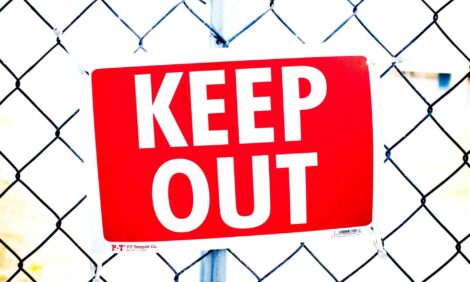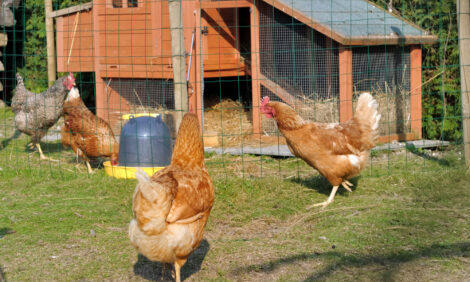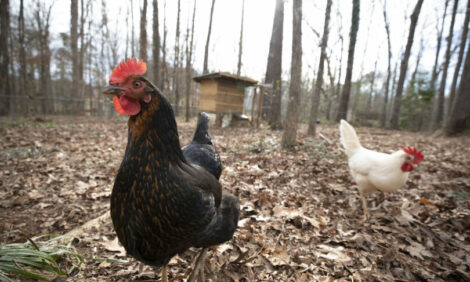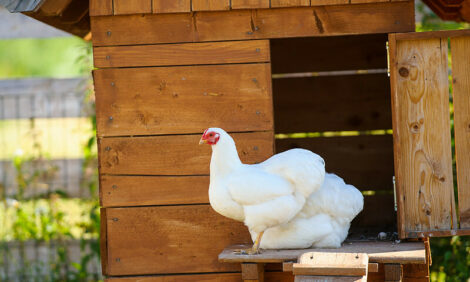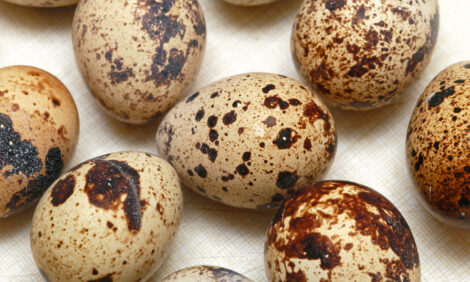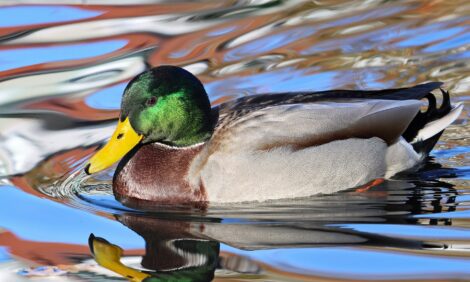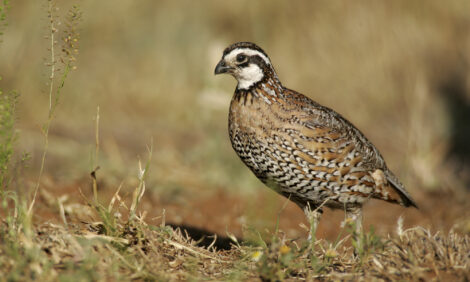



US Poultry Industry Manual - Broilers: Biosecurity
Biosecurity is critical from start to finish of a flock and should be in place on every farm - no matter the sizePart of Series:
< Previous Article in Series Next Article in Series >
Editor's Note: The following content is an excerpt from Poultry Industry Manual: The Foreign Animal Disease Preparedness and Response Plan (FAD PReP)/National Animal Health Emergency Management System (NAHEMS) Guidelines which is designed to provide a framework for dealing with an animal health emergency in the United States. Additional content from the manual will be provided as an article series.
Poultry medicine focuses on prevention through biosecurity, vaccination, medication, and harmonizing the environment. Each disease control strategy requires a financial investment with an expectation of a financial return on investment. The function of a health program is not necessarily to eradicate or completely eliminate a disease, but to find a level that will optimize return on investment.
Biosecurity encompasses procedures that reduce the probability of disease outbreaks and includes two components: a) bioexclusion prior to an outbreak (keeping pathogens out) and b) biocontainment after an outbreak (keeping pathogens from leaving an infected flock to prevent disease transmission).
Biosecurity is critical from start to finish of a flock and should be in place on every farm. Farms with poor biosecurity are vulnerable to diseases, which have the potential to ruin an entire flock. Loss of income from an entire flock is an enormous financial burden on growers. The importance of biosecurity cannot be overstated.
Conceptual Biosecurity
Conceptual biosecurity requires selecting a location for a broiler farm that will isolate the premises from other domestic poultry, wild waterfowl, and livestock, which are potential reservoirs of infectious diseases. Broiler farms should be geographically separated from other poultry units because pathogenic bacteria and viruses may be carried by the wind or by various vectors and fomites to adjacent premises. Ducks and geese are reservoirs of avian influenza and Newcastle disease viruses so broiler farms should not be located near lakes, ponds, or rivers. In addition, broiler farms should not be located near highly traveled public roads, hatcheries, feed mills, or processing plants. Single-age sites help reduce cycling of field and live vaccine viruses. Broiler houses on a farm should be separated into units that can be isolated and quarantined should the need arise.
Structural Biosecurity
Investments in biosecurity are necessary to protect broiler chickens from exposure to pathogenic micro-organisms. Buildings and other structures on the farm should be constructed to minimize the risk of infectious disease microbes entering a chicken house. Fences with gates should be built to prevent access by unauthorized visitors, wildlife, and domestic animals. Roads should be located to allow clean vehicles to approach chicken houses and to divert potentially contaminated vehicles away from the houses. Equipment and supplies to decontaminate vehicles and farm equipment should be purchased and readily available for use when needed. Showers and changing rooms should be provided for employees and visitors. Signs should be posted to serve as visual reminders of the important role of biosecurity in keeping broiler chickens healthy.
Chicken houses should be bird-proof and rodent-proof. Grain on broiler farms will always attract birds, rodents, and wild animals, such as skunks and raccoons. Houses, feed storage areas, and water sources should be constructed to exclude free-flying wild birds and rodents. Wild birds can be vectors for numerous diseases including Mycoplasma, Salmonella, and avian influenza. Rodents can be a reservoir of Salmonella or Pasteurella.
Operational Biosecurity
Operational biosecurity consists of routine procedures intended to prevent introduction of infectious disease agents. Components of a good biosecurity plan include (but are not limited to) the following measures.
Visitors, Service Technicians, and Employees • No visitors should be allowed on the farm or enter broiler chicken houses unless absolutely necessary. Footwear, hands, and clothing can carry infectious micro-organisms onto a farm. Everyone must be respectful of growers and their investments so visitor restrictions must include neighbors and contract work crews.
- Visitor logbooks should be routinely used. Visitors who have had contact with birds during the preceding 72 hours should be prohibited from entering broiler houses.
- Visitors and laborers should wear clean coveralls, hair nets, and clean footwear and must use disinfection stations provided at the door before entering a chicken house.
- Service technicians and other company personnel should wear protective coveralls, hairnets, and shoe covers. They also should use antibacterial hand sanitizer and spray tires and undersides of vehicles with an antimicrobial solution between farm visits.
- Service technicians should wash their vehicles after visiting sick chickens. When service technicians know they are going to visit a farm with sick birds, they should visit that farm last during the day.
- Employees should not have contact with other birds not owned by the business– including birds at live markets, pet birds, domestic chickens, fighting chickens, ducks, geese, waterfowl, exotic birds, quail, partridge, or pheasants. In the event that contact is made with any of the above, employees should agree to comply with a 24-hour waiting period before returning to work.
- Employees should wear clean, laundered, or new disposable coveralls and a hat in addition to disinfected rubber footwear (i.e., protective clothing).
- Disposable items used during the flock visit should be bagged and left on the farm.
Vehicles and Drivers
- All vehicles should be cleaned before entering a farm. Feed delivery trucks should be washed and sanitized between farm visits. Transport trucks and load-out equipment should be cleaned and disinfected prior to entry onto the farm.
- Drivers should wear clean boots (rubber or disposable) before getting out of the vehicle and should use a hand sanitizer before leaving and after re-entering the cab.
Equipment
- All equipment should be cleaned and disinfected before it is brought onto a farm. Equipment that has been in a chicken house should be thoroughly cleaned and disinfected before being placed back into a vehicle.
- Sharing equipment between broiler farms is not recommended. In the event that equipment must be shared, effective cleaning and disinfecting should take place between uses. Equipment should be inspected prior to entry onto the farm.
Broiler Houses
- Doors should be secure even when houses are empty and all possible entries for wild birds should be sealed and checked frequently.
- Cats and dogs should not be allowed in broiler houses because they can harbor enteric pathogens, Pasteurella in their mouths, and influenza viruses, or be mechanical carriers of pathogens on their feet, hair coat, or in their upper respiratory system.
- Footbaths should be available outside all entry points to the chicken house and everyone entering a house should dip both feet. Foot baths typically contain phenolic or quaternary ammonium antimicrobial liquids, dry chlorine, or hydrated lime powder.
Feed and Water
- Feed bins should be secured to prevent contamination by wild birds or rodents.
- Spilled feed should be cleaned up promptly to prevent attracting wild birds and rodents.
- Water sources should be secure and deny access to free-flying birds or rodents and their excreta. Water sources should be chlorinate or otherwise disinfected.
- Lids of feed bins need to fit properly and remain closed to keep rain from soaking the feed. Wet feed fosters mold growth and multiplication of micro-organisms.
Rodent and Insect Control
- Rodent control is critical for disease prevention. Rats, mice and other rodents contaminate feed and litter with Salmonella via their feces. Farms should have bait stations around the perimeter of chicken houses that prevent pets and livestock from gaining access to the bait, but provide easy access to the bait by the rodents. Rotation of bait is essential.
- Insect control also is important because insects can harbor infectious agents and permit them to survive from one flock to the next. Darkling beetles are vectors of virtually every disease known to poultry, while their larvae are destructive to insulation. The life cycle of a darkling beetle is 6-8 weeks and warm, nutrient-rich poultry house environments are ideal locations. Beetles can become resistant to pesticides, so rotation of products between flocks is necessary for optimal control.
Manure Removal and Dead Bird Disposal
- Composting should be managed to ensure that carcasses are covered to prevent access by wild animals and to maintain adequate temperatures for composting.
- When on-farm incineration is used, carcasses should be protected from exposure to wild animals.
- Trucks moving manure or dead birds should be covered to prevent dissemination of potentially contaminated feathers and follow a designated, approved route.
- Trucks moving manure or dead birds should be cleaned and disinfected after deliveries and before entering another farm. Movement of avian influenza virus between farms has been associated with contaminated rendering trucks.
Reference: "USDA APHIS | FAD Prep Industry Manuals". Aphis.Usda.Gov. 2013. https://www.aphis.usda.gov/aph...
The manual was produced by the Center for Food Security and Public Health, Iowa State University of Science and Technology, College of Veterinary Medicine, in collaboration with the USDA Animal and Plant Health Inspection Service through a cooperative agreement.









